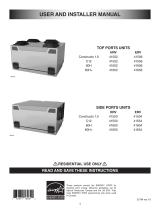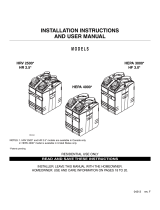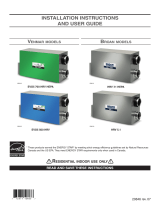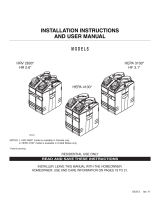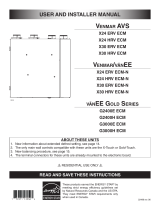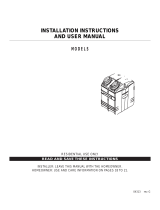Page is loading ...

21775 rev. 03
VB0139
INSTALLER: READ THESE INSTRUCTIONS
SAVE THEM FOR USER
RESIDENTIAL USE ONLY
USER AND INSTALLER MANUAL
K7 HRV (PART NO. 44150) 40H (PART NO. 44250)

2
Please take note that this manual uses the following symbols to emphasize particular information:
Identifies an instruction which, if not followed, might cause serious personal injuries including possibility of death.
CAUTION
Denotes an instruction which, if not followed, may severely damage the unit and/or its components.
NOTE: Indicates supplementary information needed to fully complete an instruction.
LIMITATION
For residential (domestic) installation only. Installation work and electrical wiring must be done by a qualified person in accordance with all
applicable codes and standards, including fire-rated construction codes and standards.
⚠ WARNING
TO REDUCE THE RISK OF FIRE, ELECTRIC SHOCK, OR INJURY TO PERSON(S) OBSERVE THE FOLLOWING:
1. Use this unit only in the manner intended by the manufacturer.
2. Before servicing or cleaning this unit, disconnect power cord from electrical outlet.
3. This unit is not designed to provide combustion and/or dilution air for fuel-burning appliances.
4. When cutting or drilling into a wall or ceiling, do not damage electrical wiring and other hidden utilities.
5. Do not use this unit with any solid-state speed control device other than those specified in section 6.1.
6. This unit must be grounded. The power supply cord has a 3-prong grounding plug for your personal safety. It must be plugged into a
mating 3-prong grounding receptacle, grounded in accordance with the national electrical code and local codes and ordinances. Do
not remove the ground prong. Do not use an extension cord.
7. Do not install in a cooking area or connect directly to any appliances.
8. Do not use to exhaust hazardous or explosive materials and vapors.
9. When performing installation, servicing or cleaning this unit, it is recommended to wear safety glasses and gloves.
10. When applicable local regulation comprises more restrictive installation and/or certification requirements, the aforementioned
requirements prevail on those of this document and the installer agrees to conform to these at his own expenses.
CAUTION
1. To avoid prematurely clogged filters, turn the unit OFF during construction or renovation.
2. Please read specification label on product for further information and requirements.
3. Be sure to duct air outside – Do not intake/exhaust air into spaces within walls or ceiling or into attics, crawl spaces, or garage. Do not
attempt to recover the exhaust air from a dryer or a range hood.
4. Intended for residential installation only in accordance with the requirements of NFPA 90B (for a unit installed in U.S.A.) or Part 9 of
the National Building Code of Canada (for a unit installed in Canada).
5. Do not run any air ducts directly above or within 2 ft (0.61 m) of a furnace or its supply plenum, boiler, or other heat producing
appliance. If a duct has to be connected to the furnace return plenum, it must be connected 10’ (3.1 m) away from plenum’s connection
to the furnace.
6. The ductwork is intended to be installed in compliance with all applicable local and national codes.
7. When leaving the house for a long period of time (more than two weeks), a responsible person should regularly check if the unit
operates adequately.
8. If the ductwork passes through an unconditioned space (e.g.: attic), the unit must operate continuously except when performing
maintenance and/or repair. Also, the ambient temperature of the house should never drop below 18°C (65°F).
9. At least once a year, the unit mechanical and electronic parts should be inspected by qualified service personnel.
10. Do not use your unit during construction or renovation of your house or when sanding drywall. Certain types of dust and vapors may
damage your system.
11. Make sure at all times that the outside intake and exhaust hoods are free from any snow during the winter season. It is important to
check your unit during a big snow storm, so it doesn’t draw in any snow. If this is the case, please turn the unit OFF for a few hours.
12. Since the electronic control system of the unit uses a microprocessor, it may not operate correctly because of external noise or very
short power failure. If this happens, unplug the unit and wait approximately 10 seconds. Then, plug the unit in again.
⚠ WARNING

3
PRODUCT REGISTRATION CARD - FICHE D’ENREGISTREMENT DU PRODUIT
Country – Pays E-mail address – Courriel Language preferred – Langue de correspondance
Address – Adresse Apt. no. – App. City – Ville Province Postal code – Code postal
First name - Prénom Last name – Nom de famille
Model no.– N
o
de modèle Serial – N
o
de série
BACK / VERSO
Centre d’enregistrement de produit - Product registration center, 550 boulevard Lemire, Drummondville, Québec Canada J2C 7W9
IMPORTANT:
Please complete and return this questionnaire within 10 days of your purchase to the address below. Note that only the questions on this side of the page are
mandatory. Your answers will be used for market research studies and reports, and will help us to better serve you in the future. IMPORTANT:
Veuillez remplir ce questionnaire
et nous le retourner dans les 10 jours suivant votre achat à l’adresse inscrite en bas de la page. Veuillez noter que seules les questions de ce côté-ci de la page sont obligatoires.
Vos réponses serviront à des études de marché et nous aideront à mieux vous servir dans l’avenir.
Date of purchase – Date d’achat
//
Telephone (day) – N
o
de téléphone (jour)
--
Telephone (evening) – N
o
de téléphone (soir)
--
no.
no.
no.
TABLE OF CONTENTS
FOR THE USER ..............................................................................................................4
1. USING THIS UNIT ........................................................................................................................4
1.1 Your ventilation system .............................................................................................................................................4
1.2 Integrated Control.....................................................................................................................................................4
2. MAINTENANCE ............................................................................................................................5
2.1 Quarterly Maintenance ............................................................................................................................................5
2.2 Annual Maintenance ................................................................................................................................................5
3. USER’S TROUBLESHOOTING ....................................................................................................5
4. WARRANTY ..................................................................................................................................6
FOR THE INSTALLER .....................................................................................................7
5. INSTALLATION .............................................................................................................................7
5.1 Locating the Unit .....................................................................................................................................................7
5.2 Installing the ductwork and registers .......................................................................................................................7
5.2.1 Fully ducted system ...............................................................................................................................................................7
5.2.2 Central draw point system - Supply Side ...............................................................................................................................8
5.2.3 Central draw point system - Return Side ...............................................................................................................................8
5.3 Installing the Exterior Hoods ...................................................................................................................................9
5.4 Installing Dual Exterior Hood Using Tandem®* Transition Kit (optional) ..................................................................9
5.5 Connecting the Ducts to the Unit ...........................................................................................................................10
5.6 Connecting the Drain .............................................................................................................................................10
6. CONTROLS ................................................................................................................................11
6.1 Optional Controls ................................................................................................................................................... 11
6.2 Electrical connection to optional control ................................................................................................................11
7. SERVICE PARTS .........................................................................................................................12
8. WIRING DIAGRAM .....................................................................................................................13
9. TROUBLESHOOTING ................................................................................................................14

4
For the User
1. USING THIS UNIT
1.1 YOUR VENTILATION SYSTEM
Your HRV is designed to provide fresh air to your home while exhausting stale, humid air. By eliminating accumulated pollutants and
humidity, it maintains an optimum air quality and an ideal relative humidity. It is equipped with a heat recovery core that is designed
specifically to control excess humidity and reduce ventilation costs by recovering the heat energy from the exhausted air, and using that
same heat energy to warm the fresh air being supplied. This heat recovery process is accomplished in such a way that the stale air is
never mixed with the fresh air.
When the outdoor temperature is below -5°C (23°F), heat recovery creates frost in the module. To maintain proper operation, the unit
is programmed to defrost the recovery module. The defrost duration and frequency vary according to the outdoor temperature. After
defrosting, the unit returns to the operating mode selected by the user.
Before using this unit for the first time, please take the time to carefully read page 2 of this guide to ensure it is
used safely and properly.
CAUTION
What problem were you trying to solve with
your purchase? (Check each one that applies
to you.)
Bad odors
Respiratory
problems
Excess of humidity
Temperature
standardization
Lack of fresh air
Dust
Mildew
Allergies
No specifi c
problems
Others
Who installed your unit?
Home builder
Recommended
installer
Friend / family
Contractor
Yourself
Please read the following list of criteria
carefully. Indicate the importance of your
purchase decision on a scale of 1 (less
important) to 5 (most important).
Price
Warranty
Product design
Ventilation
capacity
Filter maintenance
indicator
Filtration quality
Recirculation
Heat recovery
Controls
Ease of cleaning
Manufacturer’s
reputation
Ease of use
Noise level
Other
Quels problèmes essayez-vous de résoudre
par cet achat? (Cochez toutes les cases
pertinentes)
Mauvaises odeurs
Problèmes
respiratoires
Excès d’humidité
Uniformisation
de la température
Manque d’air frais
Poussières
Moisissures
Allergies
Pas de problèmes
spécifi ques
Autres (Précisez SVP)
Qui a installé l’appareil?
Constructeur
de la maison
Installateur
recommandé
Ami/membre
de la famille
Entrepreneur
Vous-même
Veuillez lire la liste des critères de sélection
ci-dessous. Sur une échelle de 1 (étant le moins
important) à 5 (étant le plus important), veuil-
lez indiquer l’importance de chacun d’entre
eux dans votre décision d’achat.
Prix
Garantie
Design du produit
Débit de
ventilation
Indicateur
d’entretien du fi ltre
Qualité de fi ltration
Recirculation
Récupération
de chaleur
Récupération
d’énergie
Fonctions
Facilité de
nettoyage
Réputation
du fabricant
Simplicité
d’utilisation
Niveau de bruit
Autres
(Précisez SVP)
Would you like to receive occasional informational e-mail off ers including
product updates and special promotions from us?
Yes/No
Aimeriez-vous recevoir plus de détails sur nos promotions, off res de rabais et mises à jour
de nos produits?
Oui/Non
Are you connected? Please do not hesitate to complete the product registration
card via our Web site at www.bnv.ca
Enregistrez-vous en ligne! N’hésitez pas à remplir la fi che d’enregistrement
du produit sur notre site Internet au www.bnv.ca
1.2 INTEGRATED CONTROL
Unit Booting Sequence
The unit’s booting sequence is similar to a personnal computer’s booting sequence. Each time the unit is plugged in after being unplugged,
or after a power failure, it will perform a 30-second booting sequence before starting to operate. No command will be taken until the
unit is fully booted.
This unit is equipped with an integrated control, located on its upper left side.
• At plug in, the unit is in Standby.
• Use the push-button to alternate between Standby and Low Speed.
• Use an optional auxiliary control to set the unit in High Speed.
For more convenience, this unit can also be controlled using an optional wall control.
For more information about their operation modes, refer to the Main and auxiliary wall
control User Guide, included with the ventilation unit and also available at www.vanee.ca or
www.venmar.ca.
VD0241
PUSH-BUTTON
Risk of electrical shocks. The unit CANNOT be turned off using its push-button control. Before performing any
maintenance or servicing, always disconnect the unit from its power source.
⚠ WARNING

5
For the User
2. MAINTENANCE
2.1 QUARTERLY MAINTENANCE
1. Unplug the unit.
2. Remove the unit door by following these steps:
A. Remove both door lower mechanical screws no. 8-32 x 1” (1) and set
aside.
B. Open (2) and lift out the door (3)
3. Slide out both filters (4) from the unit.
4. Slide out the core (5) from the unit.
5. Clean the inside walls of the unit with a clean damp cloth, then wipe with
a clean dry one.
6. Wash both core filters under lukewarm water with mild soap. Rinse
thoroughly and let dry completely before reinstalling on the core.
7. Remove the dust on the core using a vacuum cleaner and a soft brush
attachment.
8. Slide the cleaned core and filters into the unit.
9. Reinstall the door. Secure it with both mechanical screws no. 8-32 x 1” previously
removed and plug the unit. The unit will return to its previous setting after a
30-second boot sequence.
2.2 ANNUAL MAINTENANCE
Perform Quarterly Maintenance up to step 6, then perform the following:
1. Allow the core to soak for 3 hours in a solution of lukewarm water and mild liquid soap.
2. Rinse it thoroughly and shake it to remove excess water. Allow to dry and reinstall.
3. Clean the exterior hoods.
VO0191
1
2
3
AB
VD0243
4
5
Follow the instructions on the core label to reinstall it correctly.
CAUTION
Risk of electric shock. Before performing any maintenance or servicing, always disconnect the unit from its
power source.
When cleaning the unit, it is recommended to wear safety glasses and gloves.
⚠ WARNING
3. USER’S TROUBLESHOOTING
Contact customer service at 1-800-567-3855 for any unresolved issue.
PROBLEMS TRY THIS...
Nothing works.
• Make sure that the unit is plugged in.
• Make sure that the unit is receiving power from the house circuit breaker.
• Press once on the unit’s integrated push button to make sure unit is not in Stanby mode (see section 1.2)
Condensation on
windows.
(Air too humid.)
• If possible, turn the unit in high speed until the situation is corrected.
• Leave curtains half-open to allow air circulation.
• Store all firewood in a closed room with a dehumidifier or in a well ventilated room, or store the wood outdoors.
• Do not adjust the thermostat of your heating system below 18°C (64°F).
Inside air too dry. • Temporarily use a humidifier.
Air too cold at the
air supply grille.
• Do not adjust the thermostat of your heating system below 18°C (64°F).
• Make sure that the exterior hood is not blocked.
• Turn the unit in low speed.
• Install a duct heater (contact your installer)

6
For the User
4. WARRANTY
This ventilation unit is a high quality product, built and packaged with care. The manufacturer warrants to the original purchaser of its
product, that such products will be free from defects for the period stated below, from date of original purchase. For all units, the warranty
covers parts only against any operational defect. This 5-year warranty is subject to performance of the core maintenance according to the
recommendations in this manual. The heat recovery core (HRV) has a limited lifetime warranty. If any defect should occur, we urge you to
read the user guide carefully. If the problem persists, observe the following rules:
RULES TO FOLLOW
If the unit is defective, contact your ventilation contractor (see address on your manual’s cover page). The contractor will determine with
you the reason for the defect, and if needed, do the replacement or repair. If ever it is impossible to reach your ventilation contractor, call
1-800-567-3855 (North America); the personnel will be pleased to give you the phone number of a distributor or service center near you.
REPLACEMENT PARTS AND REPAIR
In order to ensure your ventilation unit remains in good working condition, you must use the manufacturer’s genuine replacement parts only.
The manufacturer’s genuine replacement parts are specially designed for each unit and are manufactured to comply with all the applicable
certification standards and maintain a high standard of safety. Any third party replacement part used may cause serious damage and
drastically reduce the performance level of your unit, which will result in premature failing. The manufacturer also recommends that you
contact a service depot certified by the manufacturer for all replacement parts and repair.
BILL OF PURCHASE
No replacement or repair covered by the warranty will be carried out unless the unit is accompanied by a copy of the original bill of
purchase. Please retain your original.
MISCELLANEOUS COSTS
In each case, the labor costs for the removal of a defective part and/or installation of a compliant part will not be covered by the manufacturer.
CONDITIONS AND LIMITATIONS
These units are created for residential use only and must be used in a building as defined below:
Building: All structures zoned and/or erected for the act, process or art of human or animal habitation and/or the storage or
warehousing of goods.
Residential use: Dwelling, lodging, suite: Building, or part of a building, intended to act as either the domicile to one or several people
which can include general sanitary, food consumption and rest facilities. Buildings of only one room or a group of
rooms including those occupied by a tenant or owner; comprise the lodgings, the individual rooms of the motels,
hotels, rooming/lodging houses, boarding/half-way/foster homes, dormitories, and suites, as well as the stores and the
business establishments constituted by only one room in a dwelling.
Commercial use: Agricultural establishment, commercial establishment for assembly, care, or detention: Building or part of a building that
does not contain a dwelling, situated on land dedicated to agriculture or farming and used primarily to shelter animals,
or for the production, the storage or the treatment of agricultural or horticultural products or animal food. Building or
part of a building, used for the display or retail of goods, professional or personal services, or commodities. Building,
or part of a building used by persons gathering for civic activities, religious or political assembly, tourism, educational/
vocational training, recreation or the consumption of food or drink. Building, or part of a building used to shelter persons
of impaired physical or psychological states, persons requiring palliative care or medical treatments, or persons for
reasons out of their control, cannot escape harm or threat of danger autonomously.
Industrial use: Building, or part of a building, used for the assembly, the manufacture, the creation, the treatment, the repair or the
storage of products and combustible materials and that contain fuels that when ignited or exploded in sufficient quantity
may constitute a risk of fire.
The above warranty applies to all cases where the damage is not a result of poor installation, improper use, mistreatment or negligence,
acts of God, or any other circumstances beyond the control of the manufacturer. Furthermore, the manufacturer will not be held responsible
for any bodily injury or damage to personal property or real estate, whether caused directly or indirectly by the unit. This warranty
supersedes all prior warranties.

7
For the Installer
5. INSTALLATION
5.1 LOCATING THE UNIT
Choose an appropriate location for the unit.
• Within an area of the house where the ambient temperature is between 10°C (50°F) and
50°C (122°F) (basement, furnace room, closet, etc.)
• Away from living areas (dining room, living room, bedroom), if possible
• So as to provide easy access to the interior of the unit, for maintenance
• Close to an exterior wall, so as to limit the length of the insulated flexible duct to and from
the unit
• Away from hot chimneys and other fire hazards
• Allow for a standard 3-prong grounding outlet within 3 feet of the unit
• Close to a drain. If no drain is close by, use a pail to collect run-off
• Slightly bend all 4 hooks located on both sides of the unit in order to hang it to ceiling joists
with the 4chains and springs provided. See illustration aside.
VD0242
Make sure the unit is level.
CAUTION
5.2 INSTALLING THE DUCTWORK AND REGISTERS
• Keep it simple. Plan for a minimum of bends and joints
• Keep the length of insulated ducts to a minimum
• If the house has two floors or more, be sure to plan for at least one exhaust register at the highest lived-in level
5.2.1 FULLY DUCTED SYSTEM
Stale air exhaust ductwork
• Install the stale air exhaust registers where the contaminants are produced:
kitchen, living room, etc. Position the registers as far from the stairway as
possible and in such a way that the air circulates in all the lived-in spaces in
the house
• If a register is installed in the kitchen, it must be located at least 4 feet (1.2 m)
away from the range
• Install the registers on an interior wall, 6 to 12 inches (152 to 305 mm) away
from the ceiling OR in the ceiling
Fresh air distribution ductwork
• Install the fresh air distribution registers in bedrooms, dining rooms, living
room and basement
• Keep in mind that the fresh air registers must be located as far as possible
from the stale air registers
• Install the registers either in the ceiling or high on the walls, with the air flow
directed towards the ceiling
• If a register must be installed in the floor, direct the airflow up the wall
• Never install a stale air exhaust register in a closed room where a combustion device operates, such as a gas
furnace, a gas water heater or a fireplace.
• When performing duct connections, always use approved tools and materials. Respect all corresponding laws
and safety regulations. Please refer to your local building code.
⚠ WARNING
VH0081
Before installing this unit, please take the time to carefully read page 2 of this guide to ensure it is installed safely
and properly.
CAUTION

8
For the Installer
5.2 INSTALLING THE DUCTWORK AND REGISTERS (CONT’D)
5.2.2 CENTRAL DRAW POINT SYSTEM - SUPPLY SIDE
Stale air exhaust ductwork
• Same as for fully ducted system (see section 5.2.1)
Fresh air distribution ductwork
• Cut an opening into the furnace supply duct at least 18 inches (0.5 m) away
from the furnace/air handler
• Connect this opening to the Fresh air distribution port of the unit (use a
metal duct, see figure aside)
• Make sure the unit duct forms an elbow inside the furnace/air handler
ductwork.
NOTE : For this type of installation, it is recommended, however not essential, that
the furnace blower be synchronized with the unit.
When performing duct connections to the furnace supply duct,
use metal ducts appropriately sized to support the additional
airflow produced by the unit.
CAUTION
5.2.3 CENTRAL DRAW POINT SYSTEM - RETURN SIDE
Stale air exhaust ductwork
• Same as for fully ducted system (see section 5.2.1)
Fresh air distribution ductwork
• Cut an opening into the furnace return duct not less than 10 feet (3.1 m) from
the furnace/air handler (A+B)
• Connect this opening to the Fresh air distribution port of the unit (see figure
beside)
NOTE : For this type of installation, it is recommended, however not essential, that
the furnace blower be synchronized with the unit.
VH0126
18” (0.5 M)
MINIMUM
VH0127
B
A
A + B = AT LEAST
10’ (3.1 M)

9
For the Installer
5.4 INSTALLING DUAL EXTERIOR HOOD USING TANDEM
®
* TRANSITION KIT (OPTIONAL)
If desired, a dual exterior hood can be used instead of 2 exterior hoods to connect
inulated ducts. The joist opening needed to install the Tandem
®
transition is 9¾”
minimum. The maximum height of the Tandem
®
transition is 8¾”.
To connect 4” insulated flexible ducts to the 5” oval ends of the Tandem
®
transition
(Exhaust air to outside and Fresh air from outside), connect an adapter to the Tandem
®
transition (not included) as follows.
For each duct connection:
1. Slightly squeeze a section of 4” round metal duct, at least 8” long, to insert it into
the oval opening of the Tandem
®
transition and push it all the way in.
2. Using silicon, seal the joint between the outside of the metal duct and Tandem
®
transition, and allow silicon to dry completely.
3. From this point on, follow the instructions included with the Tandem
®
transition kit
(part no.14690).
*Patented.
VJ0118A
VJ0119
CAUTION
When connecting insulated flexible duct to the Tandem
®
transition,
pull the interior flexible duct over the adapter all the way to the silicon
joint and secure using a tie wrap. Then pull the insulation over the
joint, making sure that no part is left without insulation.
5.3 INSTALLING THE EXTERIOR HOODS
Refer to illustration aside to connect the insulated duct to the hoods. Place
a “FRESH AIR INTAKE” sticker on corresponding hood. An “Anti-Gust
Intake Hood” should be installed in regions where a lot of snow is expected
to fall.
Make sure that both hoods are at least 18 inches above the
ground and that the intake hood is at least 6 feet (1.8m)
away from any of the following:
• Exhaust hood
• Dryer exhaust, high efficiency furnace vent, central
vacuum vent
• Gas meter exhaust, gas barbecue-grill
• Any exhaust from a combustion source
• Garbage bin and any other source of contamination
⚠ WARNING
VD0028
EXHAUST
HOOD
INTAKE
HOOD
18”
(457 MM)
18”
(457 MM)
6” ø
(152 MM)
6’
(1.8 M)
6’
(1.8 M)
18”
(457 MM)
O
PTIONAL
DUCT
LOCATION
TAPE AND DUCT TIE
CAULKING

10
For the Installer
5.5 CONNECTING THE DUCTS TO THE UNIT
NOTE: This unit was designed to be connected to ducts of at least 4” in diameter, but can be connected to bigger sized ducts by using an
appropriate transition (e.g.: 4” diameter to 5” diameter transition).
1. Pull back the insulation to expose the flexible duct.
2. Attach the flexible duct to the port using a tie wrap.
3. Pull the insulation over the joint and tuck it in between the inner and outer rings of the double collar.
4. Pull down the vapor barrier (shaded part in illustrations below) over the outer ring to cover it completely. Apply duct tape to the joint to
make an airtight seal. Avoid compressing the insulation when pulling the tape tightly around the joint.
Make sure the vapor barrier on the insulated ducts does not tear during installation to avoid condensation within
the ducts.
CAUTION
VJ0127
1
2
3
4
Non-insulated rigid ducts
Use metal screws and duct
tape to connect the rigid
ducts to the unit ports.
Non-insulated flexible
ducts
Use tie wraps to connect
the flexible ducts to the
unit ports.
VJ0073
5.6 CONNECTING THE DRAIN
1. Connect the plastic tube to the drain fitting located under the unit.
2. Make a water trap loop in the tube to prevent the unit from drawing unpleasant odors from the
drain source. Run the tube to the floor drain or to an alternative drain pipe or pail.
VO0190
VD0240A
± 1”
TIE-WRAP
CAUTION
If using a pail to collect water, locate the tube end approximately 1” into the pail
in order to prevent water from being drawn back up into the unit.

11
For the Installer
6. CONTROLS
6.1 OPTIONAL CONTROLS
This unit may be controlled using one of the following optional auxiliary wall controls:
• Dehumidistat
• 20-minute lighted push-button timer
• 60-minute crank timer
6.2 ELECTRICAL CONNECTION TO OPTIONAL CONTROL
⚠ WARNING
Always disconnect the unit before making any connections. Failure in disconnecting power could result in
electrical shock or damage of the wall control or electronic module inside the unit.
CAUTION
Make sure that there are no short-circuit between the wires or with any other components on the wall control.
Avoid poor wiring connections. To reduce electrical interference (noise) potential, do not run wall control wiring
next to control contactors or near light dimming circuits, electrical motors, dwelling/building power or lighting
wiring, or power distribution panel.
20-MINUTE
PUSH-BUTTON SWITCHES
(5 MAXIMUM)
60-MINUTE
CRANK TIMER
DEHUMIDISTAT
VE0215A
OL
OC
I
OL
OC
I
BLACK
YELLOW
GREEN
A
VR0104
B
C
ONE END OF
THE YELLOW,
GREEN, OR
BLACK UNIT WIRE
OPTIONAL
CONTROL
WIRE
USE PLIERS TO
CRIMP THE WIRE
USE FINGERS
TO CLOSE THE
CONNECTOR

12
For the Installer
VL0044
1
2
3
4
5
6
7
8
10
11
9
NO.DESCRIPTION QTY. K7 HRV 40H
1 4” Round Metal Port 2 18854
2 Electronic Board 1 19205
3 Capacitor 5 F 1 16042
4 Capacitor 13 F 1 19210
5 Filter Retaining Wires (pair) 1 19208
6 Core Filters (pair) 1 18883
7 Door Assembly 1 19201 19203
8 Heat Recovery Core 1 18884
9 Damper System Assembly 1 18882
10 Blower Assembly 1 18867
11 4” Round Port with Plastic Collar 2 18866
12 Hardware Kit (not illustrated) 1 19214
REPLACEMENT PARTS AND REPAIR:
In order to ensure your ventilation unit remains in good working condition, you must use the manufacturer genuine replacement parts only. The manufacturer
replacement parts are specially designed for each unit and are manufactured to comply with all the applicable certification standards and maintain a high
standard of safety. Any third party replacement part used may cause serious damage and drastically reduce the performance level of your unit, which will
result in premature failing. The manufacturer recommends to contact a certified service depot for all replacement parts and repair.
7. SERVICE PARTS

13
For the Installer
8. WIRING DIAGRAM
⚠ WARNING
• Risk of electrical shocks. Before performing any maintenance or servicing, always disconnect the unit from its
power source.
• This product is equipped with an overload protection (fuse). A blown fuse indicates an overload or a short-
circuit situation. If the fuse blows, unplug the product from the outlet. Discontinue using the unit and contact
technical support.
3A
K1
K2
M
M
K3
A2
J1-1
J1-2
J2-1
J2-2
J3-1
J3-2
J2-3
J5-1 J2-1 J3-1
J5-2
J2-2 J3-2
+
~
-
~
VE0216A
LINE
NEUTRAL
120 V AC
C2 M
OTOR SPEED
LOGIC DIAGRAM
C1
M1
C2
5 µF
13 µF
BK
BL
BR
J3
J2
J1
2
1
1
2
3
2
1
J7
J5
J4
1
2
1
2
3
4
5
1
2
3
4
T1
F1
A1
J9
1
2
3A
A2
5
4
3
2
1
2
1
1
2
J2
J1
J3
M2
BK
G
W
S1
STA RT
MOTOR
SPEED
ELECTRONIC ASSEMBLY
M2S-C1039A-0.1
3AG T
YPE
OVERRIDE SWITCH
(OPTIONAL)
D
AMPER ELECTRONIC
ASSEMBLY
DAMPER MOTOR
120 V AC
60 H
Z
COLOR CODE
BLACK
BLUE
BROWN
GREEN
WHITE
YELLOW
BK
BL
BR
G
W
Y
WIRING DIAGRAM
LINE VOLTAGE
CLASS 2 LOW VOLTAGE FACTORY WIRING
BLOWER MOTOR
J4-2
C1 MOTOR CAPACITOR
BLOWER MOTOR
J4-1
T1
12 VAC
24 VAC
DAMPER MOTOR
CPU
K3K2K1
3
4
5
OL
OC
I
Y
BK
G
CLASS 2 LOW VOLTAGE FIELD WIRING

14
For the Installer
9. TROUBLESHOOTING
Service technicians only: If you require assistance or have questions after performing the above troubleshooting, call: 1-800-649-0372.
Unit does not work
No
Is the power outlet
energized?
No
Refer to an
electrician.
Yes
• Unplug auxiliary controls
• Uplug unit
• Wait 1 minute. During this Ɵme, open the door.
• Plug unit back. Beware of live and moving parts.
• Unit performs a 30-second booƟng sequence. Can you hear the relays and
see the dampers move?
Isthefuseonthe
electronic board
blown?
Yes
No
Use a voltmeter.
Is there 120 VAC
between J4-1 and
J4-2?
No
Power cord is
defecƟve. Call
technical support.
Yes
Use a voltmeter.
Is there 24 VAC
between J5-1 and
J5-2?
No
Yes
Replace the
electronic board.
Replace the damper
assembly.
Yes
Does the damper
motor run beyond
the 30-second
booƟng sequence?
yes
Replace the damper
assembly.
No
Connect the GREEN and BLACK opƟonal cont rol wir es.
Reboot unit. Once the booƟng sequence is completed,
unit should start in high speed.
Does the unit now work at high speed?
Yes No
Replace the motor.
Using a mulƟmeter, verify that there is an ohm
value on the motor connector are as follows:
Between BLUE and BLACK wires
Between BLUE and BROWN wires
Between BROWN and BLACK wires
IsthereanohmvalueonallthreeconnecƟons?
Yes
Replace the board.
No
Replace the motor
and the start
capacitor.
ŝƐĐŽŶƟŶƵĞƵƐŝŶŐ
the unit and contact
technical support.
⚠ WARNING
Risk of electric shocks. Electronic board connections must be checked by qualified personnel only.
/
